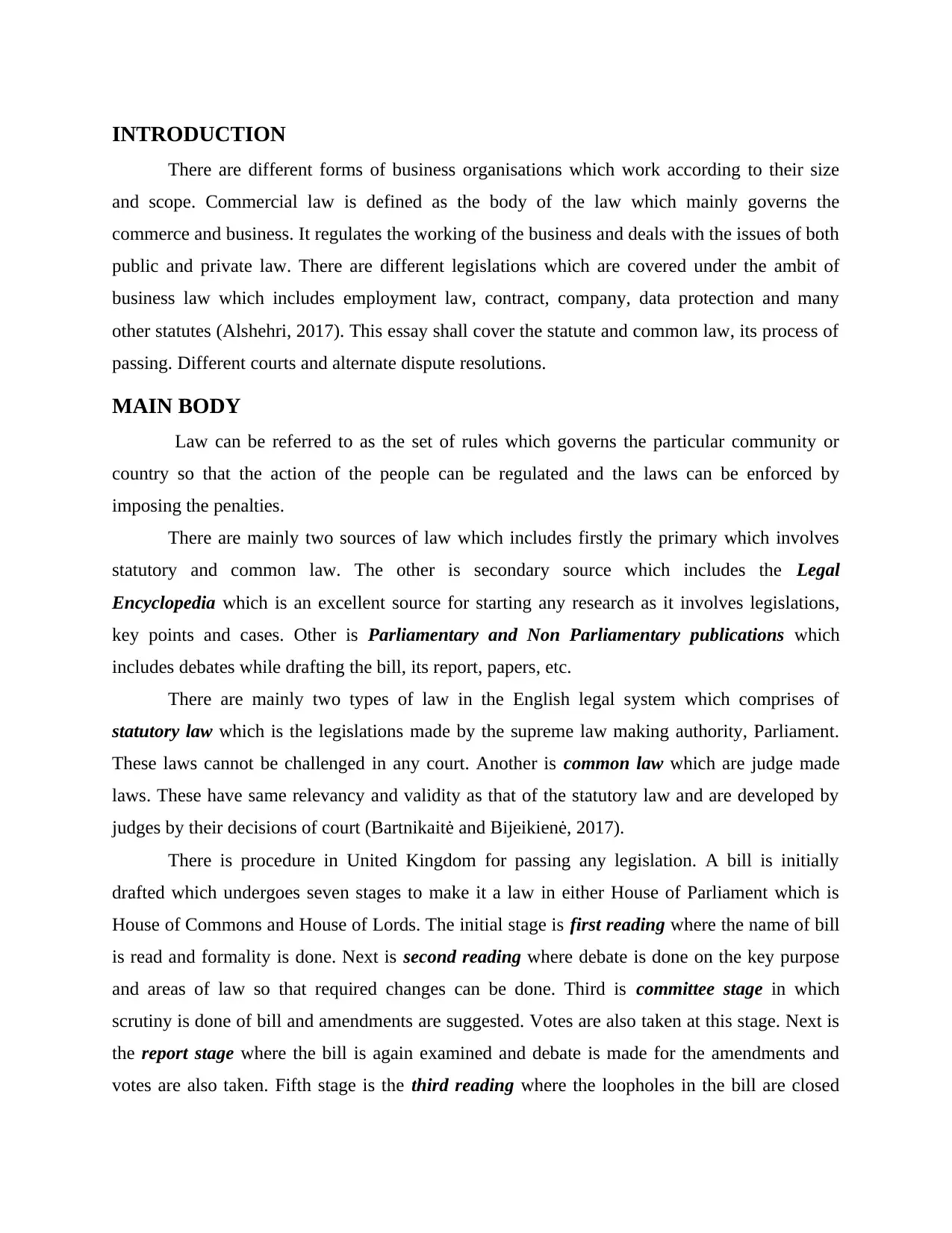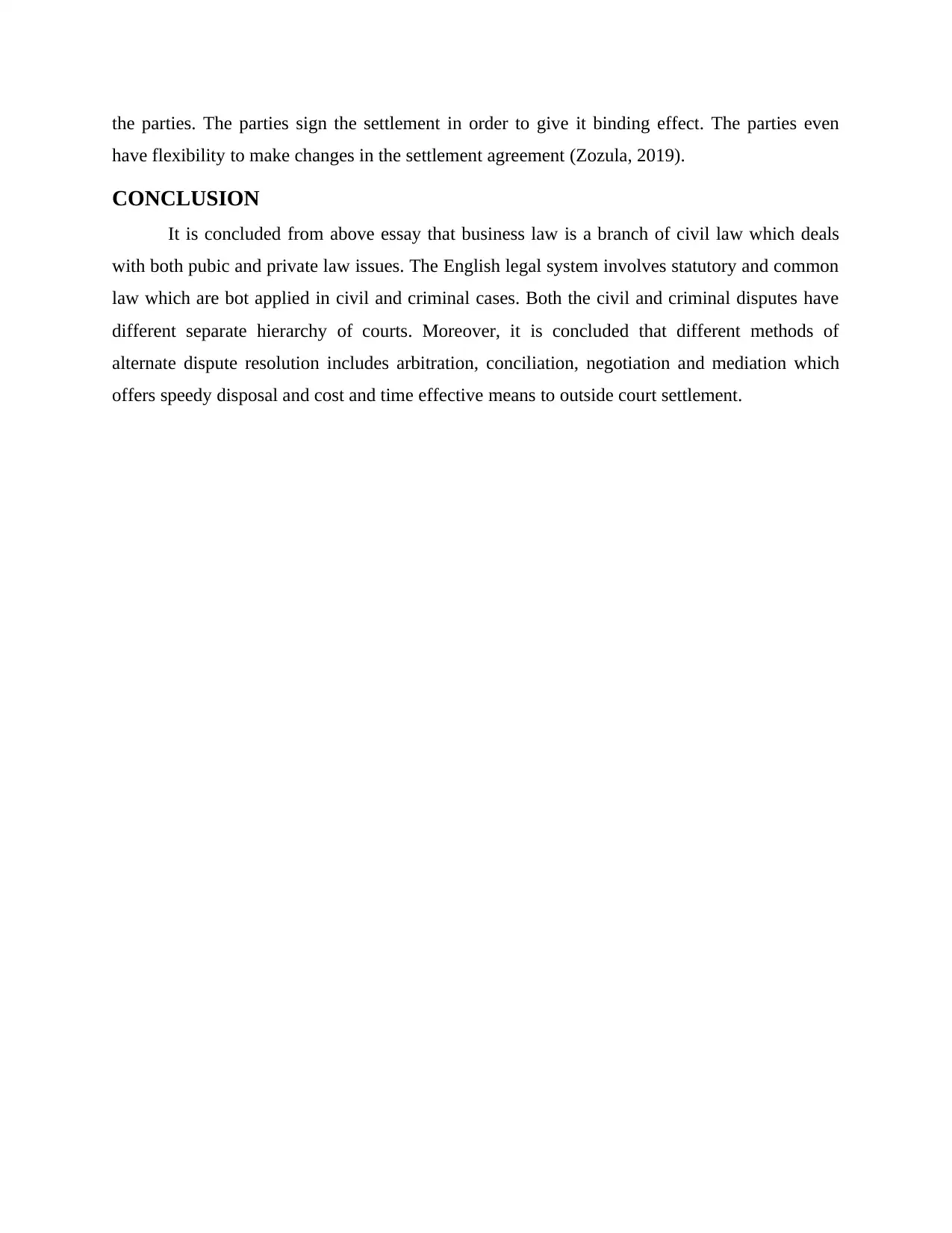Business Law: UK Legal System, Courts, and Dispute Resolution Methods
VerifiedAdded on 2022/12/14
|6
|1264
|181
Essay
AI Summary
This essay provides a comprehensive overview of business law, examining its sources, including statute and common law, and their application within the UK legal system. It details the process of passing legislation in the UK Parliament and explores the hierarchy of courts for both criminal and civil cases. The essay further investigates alternative dispute resolution methods, such as arbitration, mediation, negotiation, and conciliation, highlighting their advantages in terms of cost-effectiveness and efficiency. The analysis encompasses key legal concepts and procedures relevant to business operations, offering a clear understanding of the legal framework governing commercial activities and dispute resolution processes. The essay concludes by summarizing the key aspects of business law and the various mechanisms for resolving disputes within the legal system.

Business Law
Paraphrase This Document
Need a fresh take? Get an instant paraphrase of this document with our AI Paraphraser

Table of Contents
INTRODUCTION ..........................................................................................................................3
MAIN BODY ..................................................................................................................................3
CONCLUSION ...............................................................................................................................5
REFERENCES................................................................................................................................6
INTRODUCTION ..........................................................................................................................3
MAIN BODY ..................................................................................................................................3
CONCLUSION ...............................................................................................................................5
REFERENCES................................................................................................................................6

INTRODUCTION
There are different forms of business organisations which work according to their size
and scope. Commercial law is defined as the body of the law which mainly governs the
commerce and business. It regulates the working of the business and deals with the issues of both
public and private law. There are different legislations which are covered under the ambit of
business law which includes employment law, contract, company, data protection and many
other statutes (Alshehri, 2017). This essay shall cover the statute and common law, its process of
passing. Different courts and alternate dispute resolutions.
MAIN BODY
Law can be referred to as the set of rules which governs the particular community or
country so that the action of the people can be regulated and the laws can be enforced by
imposing the penalties.
There are mainly two sources of law which includes firstly the primary which involves
statutory and common law. The other is secondary source which includes the Legal
Encyclopedia which is an excellent source for starting any research as it involves legislations,
key points and cases. Other is Parliamentary and Non Parliamentary publications which
includes debates while drafting the bill, its report, papers, etc.
There are mainly two types of law in the English legal system which comprises of
statutory law which is the legislations made by the supreme law making authority, Parliament.
These laws cannot be challenged in any court. Another is common law which are judge made
laws. These have same relevancy and validity as that of the statutory law and are developed by
judges by their decisions of court (Bartnikaitė and Bijeikienė, 2017).
There is procedure in United Kingdom for passing any legislation. A bill is initially
drafted which undergoes seven stages to make it a law in either House of Parliament which is
House of Commons and House of Lords. The initial stage is first reading where the name of bill
is read and formality is done. Next is second reading where debate is done on the key purpose
and areas of law so that required changes can be done. Third is committee stage in which
scrutiny is done of bill and amendments are suggested. Votes are also taken at this stage. Next is
the report stage where the bill is again examined and debate is made for the amendments and
votes are also taken. Fifth stage is the third reading where the loopholes in the bill are closed
There are different forms of business organisations which work according to their size
and scope. Commercial law is defined as the body of the law which mainly governs the
commerce and business. It regulates the working of the business and deals with the issues of both
public and private law. There are different legislations which are covered under the ambit of
business law which includes employment law, contract, company, data protection and many
other statutes (Alshehri, 2017). This essay shall cover the statute and common law, its process of
passing. Different courts and alternate dispute resolutions.
MAIN BODY
Law can be referred to as the set of rules which governs the particular community or
country so that the action of the people can be regulated and the laws can be enforced by
imposing the penalties.
There are mainly two sources of law which includes firstly the primary which involves
statutory and common law. The other is secondary source which includes the Legal
Encyclopedia which is an excellent source for starting any research as it involves legislations,
key points and cases. Other is Parliamentary and Non Parliamentary publications which
includes debates while drafting the bill, its report, papers, etc.
There are mainly two types of law in the English legal system which comprises of
statutory law which is the legislations made by the supreme law making authority, Parliament.
These laws cannot be challenged in any court. Another is common law which are judge made
laws. These have same relevancy and validity as that of the statutory law and are developed by
judges by their decisions of court (Bartnikaitė and Bijeikienė, 2017).
There is procedure in United Kingdom for passing any legislation. A bill is initially
drafted which undergoes seven stages to make it a law in either House of Parliament which is
House of Commons and House of Lords. The initial stage is first reading where the name of bill
is read and formality is done. Next is second reading where debate is done on the key purpose
and areas of law so that required changes can be done. Third is committee stage in which
scrutiny is done of bill and amendments are suggested. Votes are also taken at this stage. Next is
the report stage where the bill is again examined and debate is made for the amendments and
votes are also taken. Fifth stage is the third reading where the loopholes in the bill are closed
⊘ This is a preview!⊘
Do you want full access?
Subscribe today to unlock all pages.

Trusted by 1+ million students worldwide

and a final chance is given for the amendments and votes. Next is consideration of amendments
where if house of Lords have made any change, it is send to Commons and vice versa. Last is the
royal assent where the bill is given the royal assent from the Head of State in order to enforce
the law.
The statutory and the common law both are applied in both civil and criminal cases. The
former is the Parliament made laws which is of utmost importance and is applied in both cases
and the judge made laws are aimed to interpret the statutory law so these are applied with the
changing needs of society. Its application is also ensured in every case in order to give clarity to
statutory laws (Eskini and Delfani, 2019).
There is hierarchy of court for both the criminal and civil cases. In context to criminal,
the court of first instance is the Magistrate court where the less severe offences relating to
criminal are heard and also civil cases are heard in small majority. Then any person aggrieved by
the decision of this court, may go to Crown court which hears appeal from Magistrate court and
also hears severe criminal offences. Then is the Court of Appeal- Criminal division where
appeal from Crown Court is heard and last is the Supreme court which s the last resort of appeal.
In context to civil cases, the fist instance court is County courts which hears all civil
cases. Its appeal is undergone to the High court which mainly comprises of three divisions
which includes Queen's bench, Family and Chancery. Aggrieved by the decision of any division,
the appeal then goes to the Court of Appeals- Civil division where it hears appeal from both
County and High court. Then the final appeal goes to the Supreme Court of United Kingdom.
In common, the cases or disputes are referred to the courts, but apart from the Civil
Procedure Rules of 1986 specifically provides the alternate dispute resolutions which involves
the out of court settlement. It offers speedy disposal of dispute and are cost and time effective.
The different forms of alternate dispute resolutions includes firstly the arbitration where an
independent arbitrator is appointed who mainly examines the facts and evidence on record and
pass the award which has a binding effect on parties. Second is the mediation where an unbiased
mediator is appointed who can only provide suggestions to parties but there is no binding effect
of it. Third is the negotiation where the independent third party is appoints who is obliged to
bring parties to the amicable solution so that both are placed at win win situation. Its decision is
made binding when the parties sign the agreement of negotiation. Last is the conciliation where
the conciliator is appointed who examines the evidence and facts and provide the settlement to
where if house of Lords have made any change, it is send to Commons and vice versa. Last is the
royal assent where the bill is given the royal assent from the Head of State in order to enforce
the law.
The statutory and the common law both are applied in both civil and criminal cases. The
former is the Parliament made laws which is of utmost importance and is applied in both cases
and the judge made laws are aimed to interpret the statutory law so these are applied with the
changing needs of society. Its application is also ensured in every case in order to give clarity to
statutory laws (Eskini and Delfani, 2019).
There is hierarchy of court for both the criminal and civil cases. In context to criminal,
the court of first instance is the Magistrate court where the less severe offences relating to
criminal are heard and also civil cases are heard in small majority. Then any person aggrieved by
the decision of this court, may go to Crown court which hears appeal from Magistrate court and
also hears severe criminal offences. Then is the Court of Appeal- Criminal division where
appeal from Crown Court is heard and last is the Supreme court which s the last resort of appeal.
In context to civil cases, the fist instance court is County courts which hears all civil
cases. Its appeal is undergone to the High court which mainly comprises of three divisions
which includes Queen's bench, Family and Chancery. Aggrieved by the decision of any division,
the appeal then goes to the Court of Appeals- Civil division where it hears appeal from both
County and High court. Then the final appeal goes to the Supreme Court of United Kingdom.
In common, the cases or disputes are referred to the courts, but apart from the Civil
Procedure Rules of 1986 specifically provides the alternate dispute resolutions which involves
the out of court settlement. It offers speedy disposal of dispute and are cost and time effective.
The different forms of alternate dispute resolutions includes firstly the arbitration where an
independent arbitrator is appointed who mainly examines the facts and evidence on record and
pass the award which has a binding effect on parties. Second is the mediation where an unbiased
mediator is appointed who can only provide suggestions to parties but there is no binding effect
of it. Third is the negotiation where the independent third party is appoints who is obliged to
bring parties to the amicable solution so that both are placed at win win situation. Its decision is
made binding when the parties sign the agreement of negotiation. Last is the conciliation where
the conciliator is appointed who examines the evidence and facts and provide the settlement to
Paraphrase This Document
Need a fresh take? Get an instant paraphrase of this document with our AI Paraphraser

the parties. The parties sign the settlement in order to give it binding effect. The parties even
have flexibility to make changes in the settlement agreement (Zozula, 2019).
CONCLUSION
It is concluded from above essay that business law is a branch of civil law which deals
with both pubic and private law issues. The English legal system involves statutory and common
law which are bot applied in civil and criminal cases. Both the civil and criminal disputes have
different separate hierarchy of courts. Moreover, it is concluded that different methods of
alternate dispute resolution includes arbitration, conciliation, negotiation and mediation which
offers speedy disposal and cost and time effective means to outside court settlement.
have flexibility to make changes in the settlement agreement (Zozula, 2019).
CONCLUSION
It is concluded from above essay that business law is a branch of civil law which deals
with both pubic and private law issues. The English legal system involves statutory and common
law which are bot applied in civil and criminal cases. Both the civil and criminal disputes have
different separate hierarchy of courts. Moreover, it is concluded that different methods of
alternate dispute resolution includes arbitration, conciliation, negotiation and mediation which
offers speedy disposal and cost and time effective means to outside court settlement.

REFERENCES
Books and Journals
Alshehri, S.S., 2017. The right to a fair trial within a reasonable time in criminal cases: a
comparative study between Saudi Arabia and the requirements of the European
Convention on Human Rights, using English law as an exemplar (Doctoral dissertation,
University of Dundee).
Bartnikaitė, E. and Bijeikienė, V., 2017. Perspectives in legal English in-service education:
needs analysis in Lithuanian context.
Eskini, R. and Delfani, S., 2019. The Effect of Transcending the Scope of Activities of Joint-
stock Companies by their Directors: A Comparative Study in Iranian and English Law.
Journal of Comparative Law, 5(2), pp.163-180.
Zozula, D., 2019. Features of the language of law: A comparative study of Polish, English and
Indonesian legal texts. International Journal of Legal Discourse, 4(1), pp.69-86.
Books and Journals
Alshehri, S.S., 2017. The right to a fair trial within a reasonable time in criminal cases: a
comparative study between Saudi Arabia and the requirements of the European
Convention on Human Rights, using English law as an exemplar (Doctoral dissertation,
University of Dundee).
Bartnikaitė, E. and Bijeikienė, V., 2017. Perspectives in legal English in-service education:
needs analysis in Lithuanian context.
Eskini, R. and Delfani, S., 2019. The Effect of Transcending the Scope of Activities of Joint-
stock Companies by their Directors: A Comparative Study in Iranian and English Law.
Journal of Comparative Law, 5(2), pp.163-180.
Zozula, D., 2019. Features of the language of law: A comparative study of Polish, English and
Indonesian legal texts. International Journal of Legal Discourse, 4(1), pp.69-86.
⊘ This is a preview!⊘
Do you want full access?
Subscribe today to unlock all pages.

Trusted by 1+ million students worldwide
1 out of 6
Related Documents
Your All-in-One AI-Powered Toolkit for Academic Success.
+13062052269
info@desklib.com
Available 24*7 on WhatsApp / Email
![[object Object]](/_next/static/media/star-bottom.7253800d.svg)
Unlock your academic potential
Copyright © 2020–2025 A2Z Services. All Rights Reserved. Developed and managed by ZUCOL.





